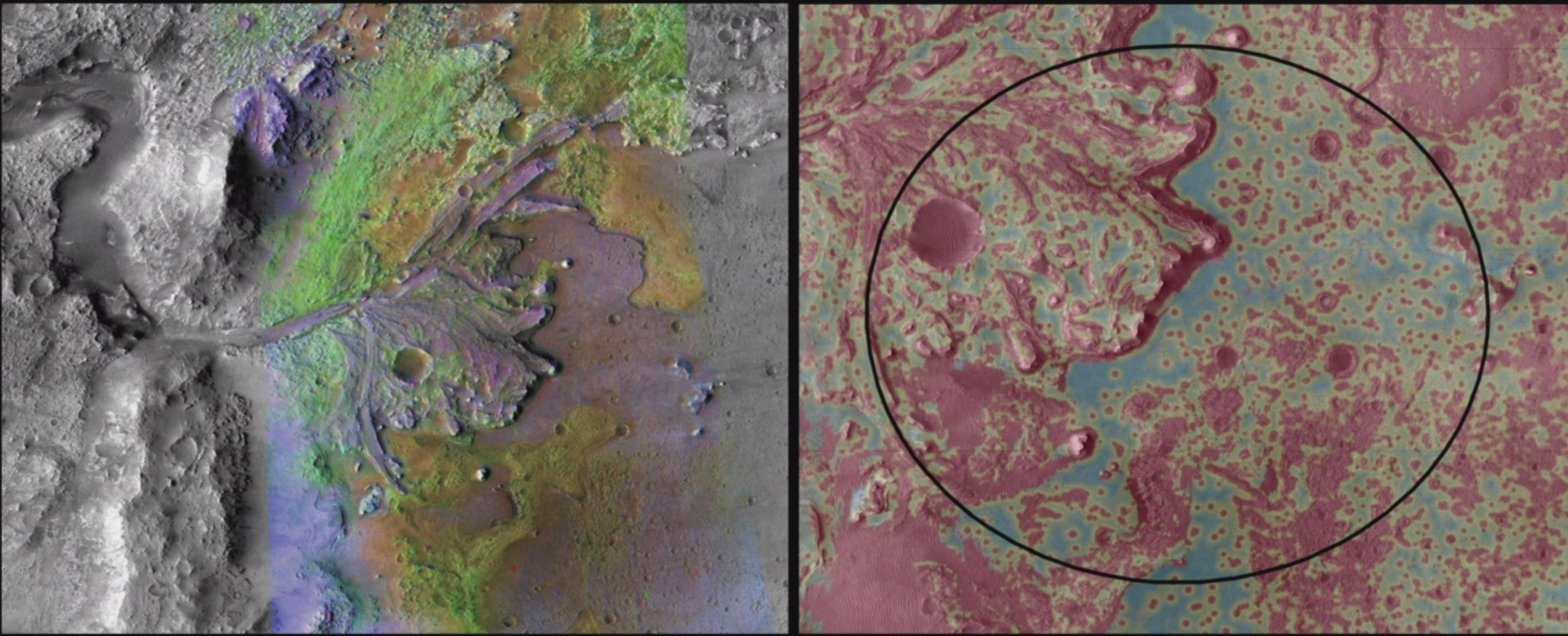Tech
NASA’s Perseverance rover is about to start searching for life on Mars
Published
3 years agoon
By
Drew Simpson
The landing
The technical terms for the seven minutes of terror is “entry, descent, and landing,” or EDL. It starts when the spacecraft enters the Martian upper atmosphere at around 20,000 kilometers per hour (12,500 miles per hour) and faces rapidly increasing temperatures. Perseverance is protected by a heat shield and shell, as well as a suite of 28 sensors that monitor hot gases and winds. Temperatures peak at a punishing 13,00 °C (2,400 °F).
About four minutes into EDL—roughly 11 kilometers (seven miles) above the surface and still hurtling to the ground at about 1,500 km/h (940 mph)—the rover deploys a 21-meter parachute The spacecraft will get rid of its heat shield soon. Underneath are a slew of other radar instruments and cameras that will be used to set the spacecraft down in a safe spot. Software called Terrain-Relative Navigation processes images taken by the cameras and compares them with an onboard topographical map to figure out where the spacecraft is and which potential safe spots it should head for.
At a little less than six minutes into EDL and around two kilometers in the air, the outer shell and parachute separate from the rover, and Perseverance heads directly for the ground. The descent stage (attached on top of the rover) uses its thrusters to find a safe spot within 10 to 100 meters of its current drop location, and slows down to around 2.7 km/h (1.7 mph). Nylon cords on the descent stage lower the rover to the ground from 20 meters (66 feet) in the air. Once the rover touches the ground, the cords are severed and the descent stage flies away to crash into the ground from a safe distance. Perseverance is now at its new home.
NASA
The science
Spirit and Opportunity helped us better understand the history of water on Mars, and Curiosity found evidence of complex organics—carbon-rich molecules that are the raw ingredients for life. Combined, this evidence told us Mars may have been habitable in the past. Perseverance is going to take the next big step:looking for signs of ancient extraterrestrial life.
Why Jezero crater? It’s a former lake bed that’s 3.8 billion years old. A river used to carry water into it, and it is at the river delta where sediments could have deposited preserved organic compounds and minerals associated with biological life.
Twenty-three cameras on Perseverance will study Mars for evidence of life. The most important of these are the Mastcam-Z camera, which can take stereoscopic and panoramic images and has an extraordinarily high zoom capability to highlight targets (such as soil patterns and old sediment formations) that deserve closer study; SuperCam, which can investigate chemical and mineral composition in the rock and has a microphone that will be used to listen to the Martian weather; and the PIXL and SHERLOC spectrometers, which will look for complex molecules that indicate biology. SHERLOC’s Watson camera will also do some microscopic imaging down to a resolution of 100 microns (hardly bigger than the width of a human hair).
Briony Horgan, a planetary scientist at Purdue University who’s part of the Mastcam-Z team, says scientists are most interested in finding organic matter that’s either heavily concentrated or could only be the result of biological activity, such as stromatolites (fossilized remains created by layers of bacteria). “If we find particular patterns, it could qualify as a biosignature that’s evidence of life,” she says. “Even if it’s not concentrated, if we see it in the right context, it could be a really powerful sign of a real biosignature.”
After Perseverance lands, engineers will spend several weeks testing and calibrating all instruments and functions before the science investigation begins in earnest. Once that’s over, Perseverance will spend a couple more months driving out to the first exploration sites at Jezero crater. We could find evidence of life on Mars as soon as this summer—if it was ever there.
New world, new tech
Like any new NASA mission, Perseverance is also a platform for demonstrating some of the most state-of-the-art technology in the solar system.
One is MOXIE, a small device that seeks to turn the carbon-dioxide-heavy Martian atmosphere into usable oxygen through electrolysis (using an electric current to separate elements). This has been done before on Earth, but it’s important to prove that it works on Mars if we hope humans can live there one day. Oxygen production could not only provide a Martian colony with breathable air; it could also be used to generate liquid oxygen for rocket fuel. MOXIE should have about 10 opportunities to make oxygen during Perseverance’s first two years, during different seasons and times of the day. It will run for about an hour each time, producing 6 to 10 grams of oxygen per session.
There’s also Ingenuity, a 1.8-kilogram helicopter that could take the first powered controlled flight ever made on another planet. Deploying Ingenuity (which is stowed underneath the rover) will take about 10 days. Its first flight will be about three meters into the air, where it will hover for about 20 seconds. If it successfully flies in Mars’s ultra-thin atmosphere (1% as dense as Earth’s), Ingenuity will have many more chances to fly elsewhere. Two cameras on the helicopter will help us see exactly what it sees. On its own, Ingenuity won’t be critical for exploring Mars, but its success could pave the way for engineers to think about new ways to explore other planets when a rover or lander will not suffice.
Neither of those demonstrations will be the marquee moment for Perseverance. The highlight of the mission, which may take 10 years to realize, will be the return of Martian soil samples to Earth. Perseverance will drill into the ground and collect more than 40 samples, most of which will be returned to Earth as part of a joint NASA-ESA mission. NASA officials suggest that this mission could come in either 2026 or 2028, which means the earliest they may be returned to Earth is 2031.
Collecting such samples is no small feat. Robotics company Maxar built the sample handling arm (SHA) that controls the drilling mechanism to collect cores of Martian soil from the ground. The company had to build something that worked autonomously, with hardware and electronics that could withstand temperature swings from -73 °C (100 °F) at night to more than 20 °C (70 °F) during the day. And most important, it had to build something that could contend with the Martian dust.
“When you’re talking about a moving mechanism that has to apply force and go exactly where you need it to go, you can’t have a tiny little dust particle stopping the whole show,” says Lucy Condakchian, the general manager of robotics at Maxar. SHA, located underneath the rover itself, is exposed to a ton of dust kicked up by the rover’s wheels or by drilling. Various innovations should help it withstand this problem, including new lubricants and a metallic accordion design for its lateral (front-to-back) movement.
Before any of those things are proved to work, however, the rover needs to make it to Mars in one piece.
“It never gets old,” says Condakchian. “I’m just as nervous as I’ve been on the previous missions. But it’s a good nervous—an excitement to be doing this again.”
You may like
-


I received the new gene-editing drug for sickle cell disease. It changed my life.
-


The Download: the origins of life, and building Facebook’s AI empire
-


The Biggest Questions: How did life begin?
-


The Download: NASA’s tiny spacecraft, and the RSV vaccine shortage
-


Downsizing and Rightsizing: How to Simplify Your Life in Retirement
-


The 10 Best U.S. Cities To Start A Career In 2023
Tech
The hunter-gatherer groups at the heart of a microbiome gold rush
Published
5 months agoon
12/19/2023By
Drew Simpson
The first step to finding out is to catalogue what microbes we might have lost. To get as close to ancient microbiomes as possible, microbiologists have begun studying multiple Indigenous groups. Two have received the most attention: the Yanomami of the Amazon rainforest and the Hadza, in northern Tanzania.
Researchers have made some startling discoveries already. A study by Sonnenburg and his colleagues, published in July, found that the gut microbiomes of the Hadza appear to include bugs that aren’t seen elsewhere—around 20% of the microbe genomes identified had not been recorded in a global catalogue of over 200,000 such genomes. The researchers found 8.4 million protein families in the guts of the 167 Hadza people they studied. Over half of them had not previously been identified in the human gut.
Plenty of other studies published in the last decade or so have helped build a picture of how the diets and lifestyles of hunter-gatherer societies influence the microbiome, and scientists have speculated on what this means for those living in more industrialized societies. But these revelations have come at a price.
A changing way of life
The Hadza people hunt wild animals and forage for fruit and honey. “We still live the ancient way of life, with arrows and old knives,” says Mangola, who works with the Olanakwe Community Fund to support education and economic projects for the Hadza. Hunters seek out food in the bush, which might include baboons, vervet monkeys, guinea fowl, kudu, porcupines, or dik-dik. Gatherers collect fruits, vegetables, and honey.
Mangola, who has met with multiple scientists over the years and participated in many research projects, has witnessed firsthand the impact of such research on his community. Much of it has been positive. But not all researchers act thoughtfully and ethically, he says, and some have exploited or harmed the community.
One enduring problem, says Mangola, is that scientists have tended to come and study the Hadza without properly explaining their research or their results. They arrive from Europe or the US, accompanied by guides, and collect feces, blood, hair, and other biological samples. Often, the people giving up these samples don’t know what they will be used for, says Mangola. Scientists get their results and publish them without returning to share them. “You tell the world [what you’ve discovered]—why can’t you come back to Tanzania to tell the Hadza?” asks Mangola. “It would bring meaning and excitement to the community,” he says.
Some scientists have talked about the Hadza as if they were living fossils, says Alyssa Crittenden, a nutritional anthropologist and biologist at the University of Nevada in Las Vegas, who has been studying and working with the Hadza for the last two decades.
The Hadza have been described as being “locked in time,” she adds, but characterizations like that don’t reflect reality. She has made many trips to Tanzania and seen for herself how life has changed. Tourists flock to the region. Roads have been built. Charities have helped the Hadza secure land rights. Mangola went abroad for his education: he has a law degree and a master’s from the Indigenous Peoples Law and Policy program at the University of Arizona.
Tech
The Download: a microbiome gold rush, and Eric Schmidt’s election misinformation plan
Published
5 months agoon
12/18/2023By
Drew Simpson
Over the last couple of decades, scientists have come to realize just how important the microbes that crawl all over us are to our health. But some believe our microbiomes are in crisis—casualties of an increasingly sanitized way of life. Disturbances in the collections of microbes we host have been associated with a whole host of diseases, ranging from arthritis to Alzheimer’s.
Some might not be completely gone, though. Scientists believe many might still be hiding inside the intestines of people who don’t live in the polluted, processed environment that most of the rest of us share. They’ve been studying the feces of people like the Yanomami, an Indigenous group in the Amazon, who appear to still have some of the microbes that other people have lost.
But there is a major catch: we don’t know whether those in hunter-gatherer societies really do have “healthier” microbiomes—and if they do, whether the benefits could be shared with others. At the same time, members of the communities being studied are concerned about the risk of what’s called biopiracy—taking natural resources from poorer countries for the benefit of wealthier ones. Read the full story.
—Jessica Hamzelou
Eric Schmidt has a 6-point plan for fighting election misinformation
—by Eric Schmidt, formerly the CEO of Google, and current cofounder of philanthropic initiative Schmidt Futures
The coming year will be one of seismic political shifts. Over 4 billion people will head to the polls in countries including the United States, Taiwan, India, and Indonesia, making 2024 the biggest election year in history.
Tech
Navigating a shifting customer-engagement landscape with generative AI
Published
5 months agoon
12/18/2023By
Drew Simpson
A strategic imperative
Generative AI’s ability to harness customer data in a highly sophisticated manner means enterprises are accelerating plans to invest in and leverage the technology’s capabilities. In a study titled “The Future of Enterprise Data & AI,” Corinium Intelligence and WNS Triange surveyed 100 global C-suite leaders and decision-makers specializing in AI, analytics, and data. Seventy-six percent of the respondents said that their organizations are already using or planning to use generative AI.
According to McKinsey, while generative AI will affect most business functions, “four of them will likely account for 75% of the total annual value it can deliver.” Among these are marketing and sales and customer operations. Yet, despite the technology’s benefits, many leaders are unsure about the right approach to take and mindful of the risks associated with large investments.
Mapping out a generative AI pathway
One of the first challenges organizations need to overcome is senior leadership alignment. “You need the necessary strategy; you need the ability to have the necessary buy-in of people,” says Ayer. “You need to make sure that you’ve got the right use case and business case for each one of them.” In other words, a clearly defined roadmap and precise business objectives are as crucial as understanding whether a process is amenable to the use of generative AI.
The implementation of a generative AI strategy can take time. According to Ayer, business leaders should maintain a realistic perspective on the duration required for formulating a strategy, conduct necessary training across various teams and functions, and identify the areas of value addition. And for any generative AI deployment to work seamlessly, the right data ecosystems must be in place.
Ayer cites WNS Triange’s collaboration with an insurer to create a claims process by leveraging generative AI. Thanks to the new technology, the insurer can immediately assess the severity of a vehicle’s damage from an accident and make a claims recommendation based on the unstructured data provided by the client. “Because this can be immediately assessed by a surveyor and they can reach a recommendation quickly, this instantly improves the insurer’s ability to satisfy their policyholders and reduce the claims processing time,” Ayer explains.
All that, however, would not be possible without data on past claims history, repair costs, transaction data, and other necessary data sets to extract clear value from generative AI analysis. “Be very clear about data sufficiency. Don’t jump into a program where eventually you realize you don’t have the necessary data,” Ayer says.
The benefits of third-party experience
Enterprises are increasingly aware that they must embrace generative AI, but knowing where to begin is another thing. “You start off wanting to make sure you don’t repeat mistakes other people have made,” says Ayer. An external provider can help organizations avoid those mistakes and leverage best practices and frameworks for testing and defining explainability and benchmarks for return on investment (ROI).
Using pre-built solutions by external partners can expedite time to market and increase a generative AI program’s value. These solutions can harness pre-built industry-specific generative AI platforms to accelerate deployment. “Generative AI programs can be extremely complicated,” Ayer points out. “There are a lot of infrastructure requirements, touch points with customers, and internal regulations. Organizations will also have to consider using pre-built solutions to accelerate speed to value. Third-party service providers bring the expertise of having an integrated approach to all these elements.”
